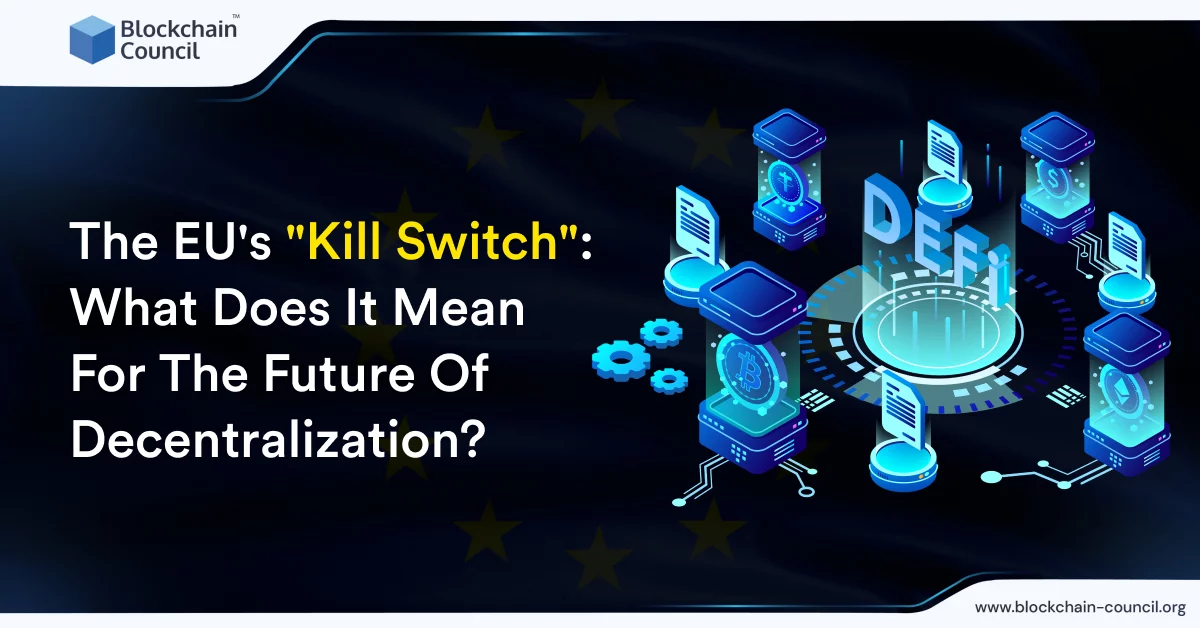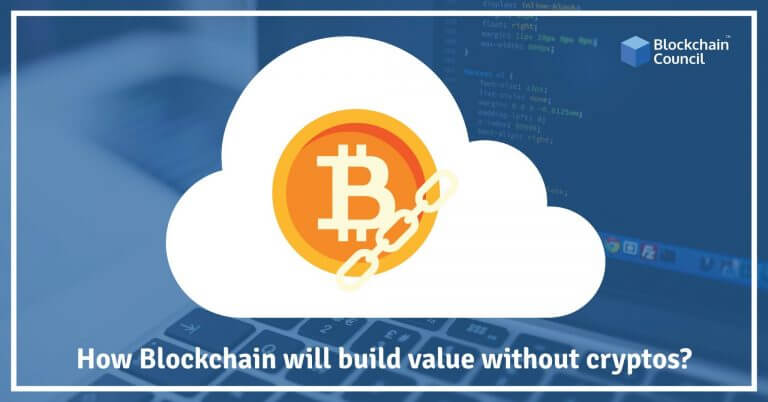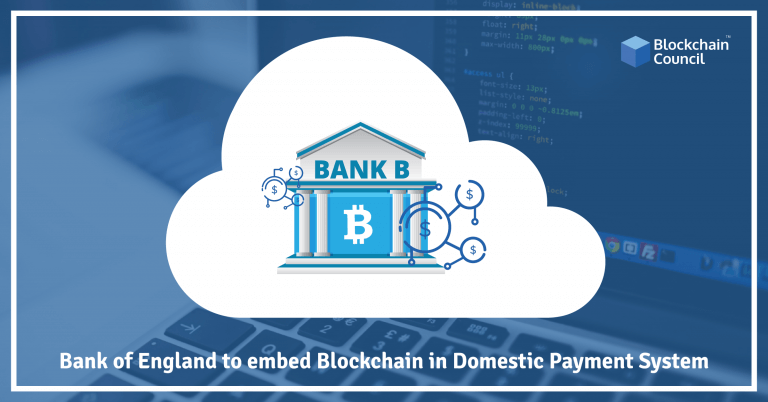
- Blockchain Council
- September 17, 2024
Summary:
- The European Parliament passed a bill on March 14 to protect data privacy while promoting innovation, but a controversial clause known as the Data Act has raised alarm bells in the Blockchain ecosystem.
- Article 30 of the Data Act requires all smart contracts to include a mechanism that can either destroy the contract or pause its operation in the event of a major bug or security breach.
- The provision aims to ensure that a mechanism exists to terminate the continued execution of transactions and that the smart contract includes internal functions which can reset or instruct the contract to stop or interrupt the operation to avoid future accidental executions.
- The language of the Data Act is currently vague, leaving room for interpretation and speculation, and the conditions under which non-consensual termination or interruption of a smart contract would be permissible are not clearly defined.
- Many in the crypto community worry that the kill switch could give regulators and government entities too much power over decentralized finance (DeFi) and other Blockchain-based systems.
- Many in the crypto community worry that the kill switch could give regulators and government entities too much power over decentralized finance (DeFi) and other Blockchain-based systems.Some argue that the kill switch is a necessary evil, a way to ensure that smart contracts can be terminated in the event of a significant security breach or bug, while others worry that it could be used to unfairly manipulate contracts and stifle innovation.
- The kill switch was introduced to ensure that smart contracts are secure and to prevent unauthorized access or data breaches, and it can provide compliance with GDPR, consumer protection, and regulatory compliance.
- Ultimately, it will be up to individual companies and organizations to decide how they want to incorporate the kill switch into their smart contracts.
As the world continues to evolve, so do our technological advancements. One of the most recent developments in the European Union (EU) is the introduction of the smart contract “kill switch.” But what exactly is it, and how does it affect the world of decentralization?
The EU parliament recently passed a bill requiring smart contracts to include a kill switch. This means that in the event of a security breach or other emergency, the switch can be used to terminate the contract and prevent any further action from taking place. Some have expressed concern about the impact this could have on the autonomy of smart contracts, but others argue that it is a necessary precaution to prevent potential damage.
The EU’s Smart Contact “Kill Switch”
On March 14, the European Parliament passed a bill designed to protect data privacy while promoting innovation, but a controversial clause known as the Data Act has raised alarm bells in the Blockchain ecosystem. Essentially, the new law requires all smart contracts to include a mechanism that can either destroy the contract or pause its operation in the event of a major bug or security breach.
This mechanism is commonly used by administrators to shut off a device or software in the event of a security threat. In a smart contract setting, the kill switch can either destroy the contract or deploy a halt, patch, and re-release of the contract in the case of a major bug or breach.
Article 30 of the Data Act requires smart contracts to have a clearly defined mechanism to terminate or interrupt their operation. The provision aims to ensure that a mechanism exists to terminate the continued execution of transactions and that the smart contract includes internal functions which can reset or instruct the contract to stop or interrupt the operation to avoid future accidental executions. The conditions under which a smart contract could be reset or instructed to stop or be interrupted should be clearly and transparently defined.
The other provisions in Article 30 are less controversial. Section B of the article requires smart contract providers to incorporate control mechanisms for terminating transaction execution, which offers an extra layer of security against exploits. However, this focus may offer some contradictions to what DeFi is supposed to be. Smart contracts are supposed to provide autonomy in transactions, thus eliminating third parties.
At first glance, this might seem like a sensible precaution. After all, we’re all concerned about cyber attacks and data breaches these days. But in the world of Blockchain and cryptocurrency, where autonomy and decentralization are key tenets, the idea of a “kill switch” has ignited a firestorm of controversy. Many in the crypto community worry that the kill switch could give regulators and government entities too much power over decentralized finance (DeFi) and other Blockchain-based systems.
What’s more, the language of the Data Act is currently vague, leaving room for interpretation and speculation. Is the kill switch really a self-destruct button? Or is it more like a pause function, which can freeze a smart contract until the situation is resolved? And what exactly are the conditions under which non-consensual termination or interruption of a smart contract would be permissible? These questions and more have been swirling around the Blockchain community since the passage of the Data Act.
Some argue that the kill switch is a necessary evil, a way to ensure that smart contracts can be terminated in the event of a major security breach or bug. Others worry that the kill switch is a slippery slope, a tool that could be abused by regulators or powerful entities to control and manipulate the Blockchain ecosystem. As with most things in life, the truth probably lies somewhere in between.
Also read Google Enters AI “War” with Bard: Did it use ChatGPT’s Data to Train it?
Why did the EU introduce it?
The European Union introduced the smart contract kill switch as part of its Data Act to address data privacy without stifling innovation. The aim was to give people more control over their personal information. The kill switch was introduced to ensure that smart contracts are secure and to prevent unauthorized access or data breaches. However, the introduction of the kill switch has generated concerns in the Web3 community. Some fear that the kill switch mandate would curb the decentralization of smart contracts by giving one person or a group of people the power to shut down operations.
How the “Kill Switch” Affects Decentralization
So, how dangerous is the smart contract kill switch? It really depends on who you ask. Some argue that it is a necessary tool to prevent hacks and other security breaches from causing serious damage, while others worry that it could be used to manipulate contracts unfairly and stifle innovation. Ultimately, it will be up to individual companies and organizations to decide how they want to incorporate the kill switch into their smart contracts
Pros of the “Kill Switch” for Decentralization
Proponents of the smart contract kill switch argue that it provides a safety net for consumers and prevents incidents such as the DAO hack of 2016, which resulted in millions of dollars worth of cryptocurrency being stolen due to a flaw in a smart contract. On the other hand, critics suggest that the kill switch undermines the very purpose of smart contracts, which is to enable trustless, decentralized transactions without the need for intermediaries.
Despite this controversy, the European Union believes that the smart contract kill switch offers significant benefits, such as:
Compliance with GDPR
The General Data Protection Regulation (GDPR) requires companies to ensure the security and protection of personal data. If a smart contract processes personal data, a kill switch can provide a way to stop the processing if a breach or security issue is detected. This feature offers an added layer of security to ensure that personal data is not compromised and reinforces trust in the technology.
Consumer Protection
If a smart contract is used in a consumer-facing application, such as an e-commerce platform, a kill switch can protect consumers in case of a malfunction or vulnerability in the smart contract. This can help prevent financial losses and ensure consumers’ trust in the platform. With the integration of a smart contract kill switch, users can have peace of mind knowing that they are protected from potential losses due to technical issues.
Regulatory Compliance
In the EU, financial services are heavily regulated, and smart contracts used in financial applications need to comply with various regulations, such as the Markets in Financial Instruments Directive (MiFID II). A kill switch can provide a way to comply with these regulations by allowing the suspension or termination of a smart contract in case of a violation. This feature is particularly crucial in ensuring that financial transactions are conducted in a secure and compliant manner.
Risk Management
Smart contracts can be used in applications involving high risks, such as insurance or derivatives trading. A kill switch can help manage these risks by pausing or terminating the contract if certain conditions are met, such as a sudden market crash or a security breach. When compared with a classic kill switch mechanism, the pause functionality represents a better fail-safe. Not only does it protect the network if caught on time, but it also salvages the contract – and its funds – by enabling it to resume operations.
However, with the pause functionality comes the question of security. To pause the smart contract, code admins need to use the system’s private key, which becomes vulnerable to cyber-attacks once used online. In theory, access to this private key could give hackers admin privileges to the entire contract and could compromise the immutability of smart contracts.
To address this concern, smart contract admins can deploy a pause functionality without endangering the security of the entire smart contract by using different keys. One key enables the pause functionality, while another enables the unpause functionality, with both keys stored in an offline manner for added security. Separating the pause and unpause keys and storing both in a truly offline manner strengthens the security of the smart contract and eliminates potential points of failure.
Also, read Top 5 Ways To Recover Funds From Crypto Currency Scam
Cons of the “Kill Switch” for Decentralization
There are also drawbacks to the smart contract kill switch that must be considered. For instance, on August 30, 2022, OptiFi, a decentralized exchange, accidentally triggered a kill switch to its mainnet. This kill switch led to a permanent shutdown and the loss of USDC stablecoin tokens worth $661,000. While this kill switch was not utilized in a smart contract setting, it highlighted the risks that a classic kill switch poses on crypto-related projects and businesses.
Become a Certified Smart Contract Auditor™
The Future of Decentralization
The future of decentralization is uncertain, but many predictions suggest that it will continue to play an important role in the world of finance and beyond. Decentralized finance (DeFi) has already made significant strides in disrupting the traditional finance industry, and this trend is likely to continue. In addition, Blockchain technology has the potential to revolutionize many other industries, such as healthcare, supply chain management, and even voting.
However, the EU’s smart contract “kill switch” mandate could pose a significant challenge to the decentralization movement. Many Blockchain enthusiasts argue that the mandate is a step in the wrong direction and that it goes against the very nature of decentralization. It remains to be seen how the mandate will affect the development and adoption of Blockchain technology in Europe and around the world.
Impact of the “Kill Switch” on the Future of Decentralization
The impact of the EU’s smart contract “kill switch” mandate on the future of decentralization is complex and multifaceted. On the one hand, the mandate could prevent harmful or fraudulent smart contracts from causing widespread damage, which could help to build trust in the Blockchain ecosystem. On the other hand, the mandate could stifle innovation and limit the potential of Blockchain technology by centralizing control in the hands of a few authorities.
Many experts argue that the key to striking a balance between these two concerns is to design smart contracts that incorporate decentralized governance mechanisms. Decentralized governance mechanisms enable stakeholders to participate in the decision-making process and ensure that the system remains transparent and accountable. By incorporating such mechanisms, smart contracts can become more resilient and less vulnerable to abuse.
How can companies adapt to the changing landscape?
As the landscape of Blockchain technology continues to evolve, companies will need to adapt to stay competitive. One way that companies can adapt is by embracing decentralization and exploring the potential of Blockchain technology. By doing so, companies can gain a competitive advantage by reducing costs, increasing efficiency, and improving transparency.
In addition, companies will need to consider the implications of the EU’s smart contract “kill switch” mandate and how it could affect their operations. Companies may need to re-evaluate their smart contract design and governance mechanisms to ensure that they are compliant with the mandate while still retaining the benefits of decentralization.
Further Implications
The recent passing of the EU’s Smart Contract “Kill Switch” has been met with mixed reactions from experts in the Blockchain and cryptocurrency space. The mandate requires smart contracts to include a kill switch that allows the contract’s administrator to stop or reset it, which some argue could potentially undermine the very purpose of decentralized finance systems.
Implications for Privacy and Security
The EU’s Smart Contract “Kill Switch” mandate has raised concerns among experts about its potential impact on privacy and security. Smart contracts are designed to operate without the need for intermediaries, providing a secure and decentralized way to conduct transactions. However, the inclusion of a kill switch means that a third party can potentially intervene in the contract’s operation, compromising the privacy and security of the parties involved.
The kill switch could be used to monitor or interfere with the contract’s operations, resulting in a breach of privacy and security. Furthermore, the presence of a central authority controlling the kill switch goes against the very nature of decentralized finance, which aims to provide financial services that are not controlled by a single entity.
Potential for Abuse
The Kill Switch mandate also raises concerns about the potential for abuse. The presence of a kill switch could provide a powerful tool for governments or other authorities to intervene in decentralized systems, which may have unintended consequences. In addition, the inclusion of a kill switch could be used to silence dissent or stifle innovation.
There is also the potential for the kill switch to be misused by contract administrators, which could result in serious consequences for the parties involved. The ability to stop or reset a contract can be seen as a form of centralized control, which goes against the very ethos of Blockchain and cryptocurrency.
Alternative Approaches to Maintaining Security
While the EU Smart Contract Kill Switch mandate has raised concerns, there are alternative approaches to maintaining security that do not involve the inclusion of a kill switch. One approach is to use multi-signature wallets, which require multiple parties to authorize transactions, providing an additional layer of security.
Conclusion
In conclusion, the European Parliament’s Data Act includes a controversial clause known as the “kill switch” for smart contracts, which requires them to include a mechanism to pause or terminate their operation in the event of a major bug or security breach. This provision aims to ensure security, compliance with GDPR, consumer protection, regulatory compliance, and risk management.
However, it has ignited a firestorm of controversy in the Blockchain community, as some worry that the kill switch could give regulators and government entities too much power over DeFi and other Blockchain-based systems. Whether the smart contract kill switch is a necessary tool or a slippery slope is still up for debate, and it remains to be seen how individual companies and organizations will incorporate it into their smart contracts.
Frequently Asked Questions
- The Data Act is a bill passed by the European Parliament to protect data privacy and promote innovation.
- The controversial clause is the “kill switch” requirement for smart contracts, which can either destroy or pause the contract in case of a major bug or security breach.
- The EU introduced the kill switch to address data privacy without stifling innovation.
- It aims to give people more control over their personal information and prevent unauthorized access or data breaches.
- Proponents argue that it provides a safety net for consumers and prevents incidents such as the DAO hack of 2016.
- Critics suggest that it undermines the purpose of smart contracts, which is to enable trustless, decentralized transactions without intermediaries.
- Compliance with GDPR: a kill switch can provide a way to stop processing personal data if a breach or security issue is detected, complying with GDPR.
- Consumer Protection: a kill switch can protect consumers from losses due to technical issues, reinforcing trust in the platform.
- Regulatory compliance: a kill switch can provide a way to comply with financial regulations, such as the Markets in Financial Instruments Directive (MiFID II).
- Some fear that the kill switch mandate would curb the decentralization of smart contracts by giving one person or a group of people the power to shut down operations.
- The language of the Data Act is currently vague, leaving room for interpretation and speculation.
- It could be used to unfairly manipulate contracts and stifle innovation.


































































 Guides
Guides News
News Blockchain
Blockchain Cryptocurrency
& Digital Assets
Cryptocurrency
& Digital Assets Web3
Web3 Metaverse & NFTs
Metaverse & NFTs
